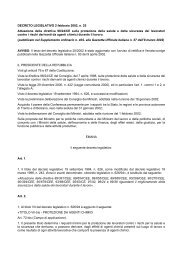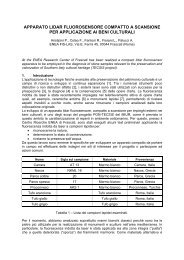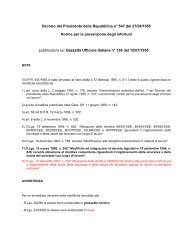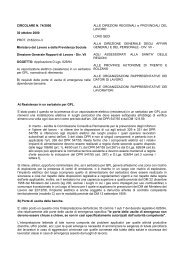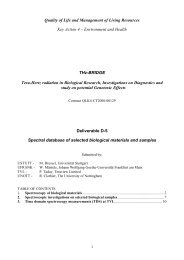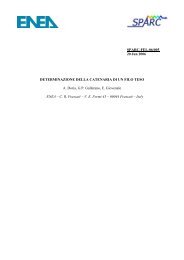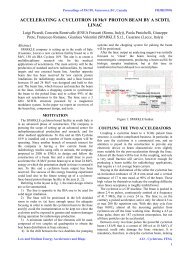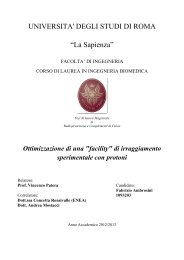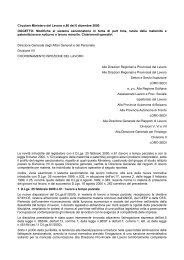Theory, Design and Tests on a Prototype Module of a Compact ...
Theory, Design and Tests on a Prototype Module of a Compact ...
Theory, Design and Tests on a Prototype Module of a Compact ...
You also want an ePaper? Increase the reach of your titles
YUMPU automatically turns print PDFs into web optimized ePapers that Google loves.
20 2. LINAC AND SCL ACCELERATORS<br />
reducti<strong>on</strong> in the transmissi<strong>on</strong> is quadrupole displacement. For a displacement<br />
error tolerance <strong>of</strong> 0.1 mm there is a 90% probability that<br />
the transmissi<strong>on</strong> will be greater than 10%.<br />
4.2. Mechanical Aspects. All LIBO modules are essentially identical,<br />
except for their progressive increase in length, corresp<strong>on</strong>ding to<br />
the increasing velocity <strong>of</strong> the prot<strong>on</strong>s. There are three basic elements<br />
that compose the accelerating structure in each module: the half-cellplate,<br />
the bridge coupler <str<strong>on</strong>g>and</str<strong>on</strong>g> the end cell. Each module c<strong>on</strong>tains 102<br />
half-cell-plates, 3 bridge couplers <str<strong>on</strong>g>and</str<strong>on</strong>g> 2 end cells. The half-cell-plate is<br />
the basic building block <strong>of</strong> a tank. It is a rectangular plate c<strong>on</strong>taining<br />
half <strong>of</strong> an accelerating <str<strong>on</strong>g>and</str<strong>on</strong>g>, at the reverse side, half <strong>of</strong> a coupling cell.<br />
Apart from the slight difference in length, the shape <strong>of</strong> the cells remains<br />
the same in all the modules. All accelerating cells in a tank have the<br />
same length; the length <strong>of</strong> the coupling cells as well as the shape <strong>of</strong> the<br />
coupling slots between the accelerating <str<strong>on</strong>g>and</str<strong>on</strong>g> coupling cells do not vary<br />
over the whole module.<br />
The bridge couplers <str<strong>on</strong>g>and</str<strong>on</strong>g> end cells (see figure 2.11) have stainless<br />
steel flanges <str<strong>on</strong>g>and</str<strong>on</strong>g> cylindrical inserts brazed into them to fix the module<br />
<strong>on</strong> the girder, thus minimizing stress <str<strong>on</strong>g>and</str<strong>on</strong>g> deformati<strong>on</strong> in the s<strong>of</strong>t copper.<br />
C<strong>on</strong>necti<strong>on</strong>s to the beam line at both ends <strong>of</strong> the module <str<strong>on</strong>g>and</str<strong>on</strong>g> the<br />
pumping ports to the vacuum manifold are also in stainless steel.<br />
In each bridge coupler <str<strong>on</strong>g>and</str<strong>on</strong>g> in the end cells are housed PMQs for<br />
beam focussing, pick-up loops for RF field measurements, <str<strong>on</strong>g>and</str<strong>on</strong>g> movable<br />
tuners for frequency correcti<strong>on</strong>s after the whole module has been<br />
brazed. The finished <str<strong>on</strong>g>and</str<strong>on</strong>g> brazed copper structure is mounted <strong>on</strong> a rigid<br />
girder, <strong>on</strong>to which an external reference is fixed for alignment purposes.<br />
All copper pieces for LIBO have been machined <strong>on</strong> numericallyc<strong>on</strong>trolled<br />
lathe <str<strong>on</strong>g>and</str<strong>on</strong>g> milling machines. The manufacturing precisi<strong>on</strong> <strong>of</strong><br />
the structure must take into account RF, brazing <str<strong>on</strong>g>and</str<strong>on</strong>g> alignment specificati<strong>on</strong>s.<br />
Typical tolerance values are ±10 to 20 mm with 0.4 mm<br />
roughness for RF surfaces <str<strong>on</strong>g>and</str<strong>on</strong>g> 0.8 mm for brazed surfaces. The halfcell-plates<br />
are made <strong>of</strong> laminated OFE copper. Pre-machining, followed<br />
by a 250 ◦ C stress relieving in air was used to obtain the 20 mmplanarity<br />
for vacuum brazing after the final machining. Bridge couplers<br />
<str<strong>on</strong>g>and</str<strong>on</strong>g> end cells are <strong>of</strong> forged OFE copper, while for flanges, manifolds<br />
<str<strong>on</strong>g>and</str<strong>on</strong>g> fixing points, forged 316 LN stainless steel is used. For the brazing<br />
<strong>of</strong> the end cells, bridges <str<strong>on</strong>g>and</str<strong>on</strong>g> half-cell-plates, where the surfaces to be<br />
brazed must be in horiz<strong>on</strong>tal positi<strong>on</strong>, several grooves are machined in<br />
the bottom surfaces <strong>of</strong> the pieces, while the upper surfaces are perfectly<br />
flat, see figure 2.13. The positi<strong>on</strong>s <str<strong>on</strong>g>and</str<strong>on</strong>g> dimensi<strong>on</strong>s <strong>of</strong> these grooves, determining<br />
the quantity <strong>of</strong> the brazing alloy, have been tested <strong>on</strong> sample<br />
pieces with an automatic total-immersi<strong>on</strong> ultras<strong>on</strong>ic testing method.<br />
All <strong>of</strong> the half-cell-plates are machined with the external surfaces as<br />
reference, <str<strong>on</strong>g>and</str<strong>on</strong>g> then these surfaces are used for the alignment during







